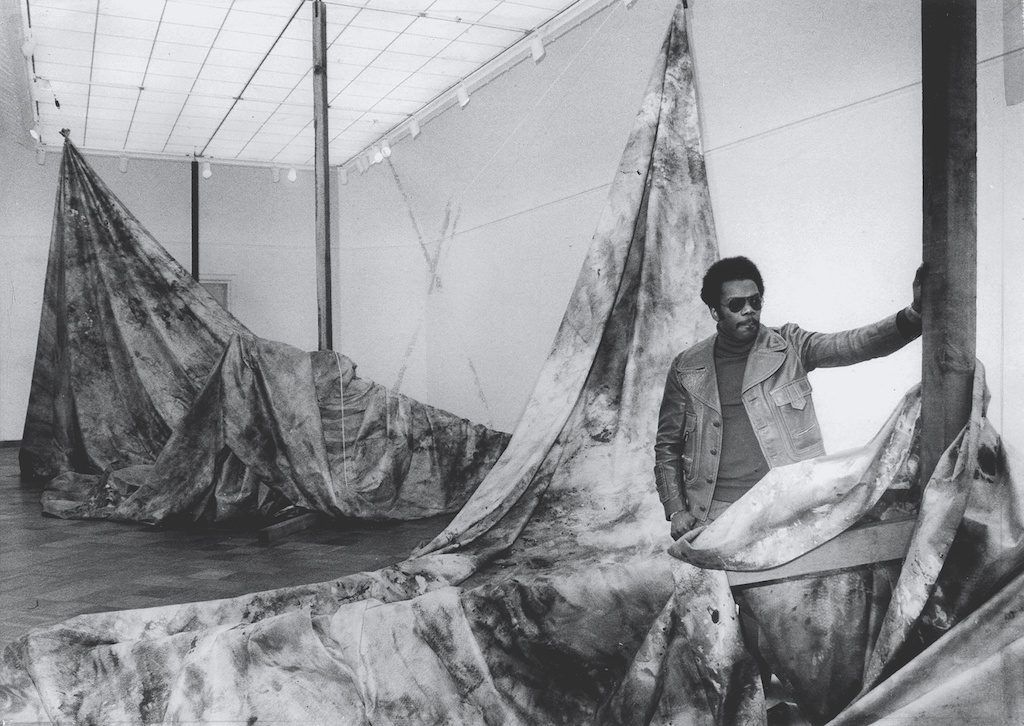[ad_1]
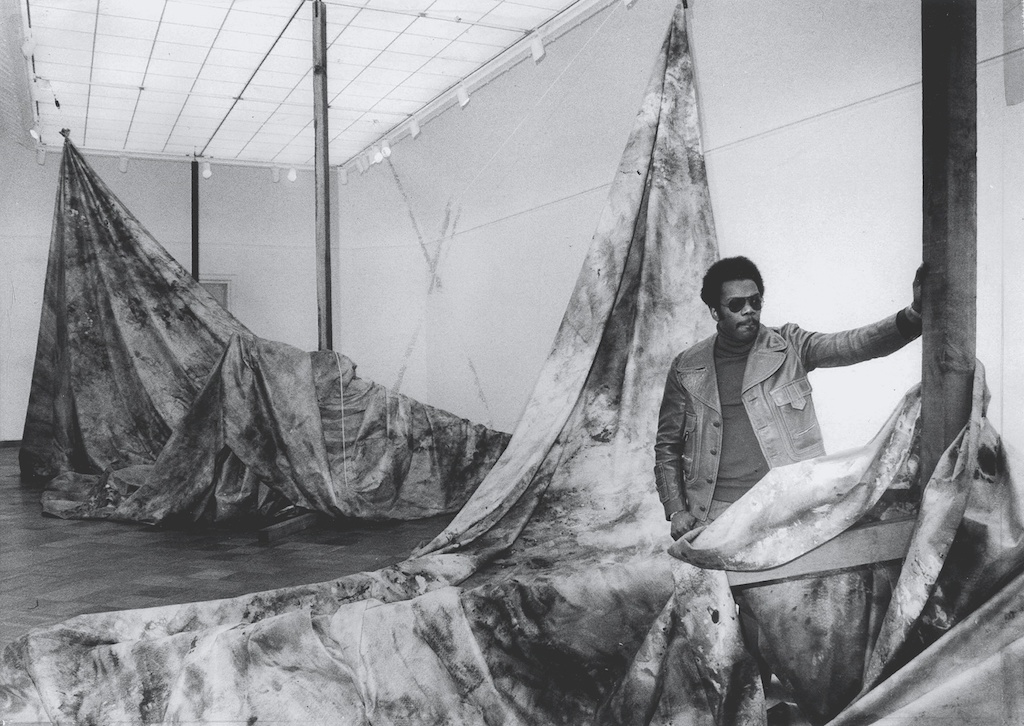
Sam Gilliam with his 1973 painting Autumn Surf.
ART FRISCH/COURTESY SAN FRANCISCO CHRONICLE/©2018 PROLITTERIS, ZURICH
Sam Gilliam’s abstract canvases from the 1960 and ’70s, which often dramatically defy the oil-on-canvas-hung-on-a-wall formula, went largely unseen in many mainstream institutions and galleries for years. That began to change a few years ago. Now, some of his paintings sell for more than $1 million, and his work has become a staple in permanent-collection hangs. Gilliam’s paintings are currently the subject of “The Music of Color: Sam Gilliam, 1967-1973,” an exhibition at the Kunstmuseum Basel in Switzerland that surveys the artist’s output during that time period. With that show in mind, below is an interview Sam Gilliam did with ARTnews, first published in this magazine’s January 1973 issue. Among the many topics addressed is the concept of “black art”—a label that continues to be divisive. Who, Gilliam is asked, is proud of the achievements of black artists in America? “I am,” he responds. The interview follows in full below. —Alex Greenberger
“Hanging loose: An interview with Sam Gilliam”
By Donald Miller
January 1973
Last summer the paintings of Sam Gilliam, together with work by Diane Arbus, Ron Davis, Richard Estes, James Nutt and Keith Sonnier, were selected by Walter Hopps, former director of the Corcoran Gallery of Art, to be shown in the American Pavilion of the 36th Venice Biennale. Gilliam lives in Washington, D.C. Born in Tupelo, Miss., in 1933, he grew up in Louisville, Ky. He attended the University of Louisville, earning a master’s degree in 1961. He taught at McKinley High School, Washington, D.C., and became associated with the Washington school of color-field painting. More recently he has produced unstretched as well as stretched paintings. They have been widely exhibited and are in more than 13 public collections. Gilliam was an artist fellow of the Washington Gallery of Modern Art Workshop Program, 1968. In 1971 he exhibited in the Museum of Modern Art’s Projects series and also received a Guggenheim Foundation Award.
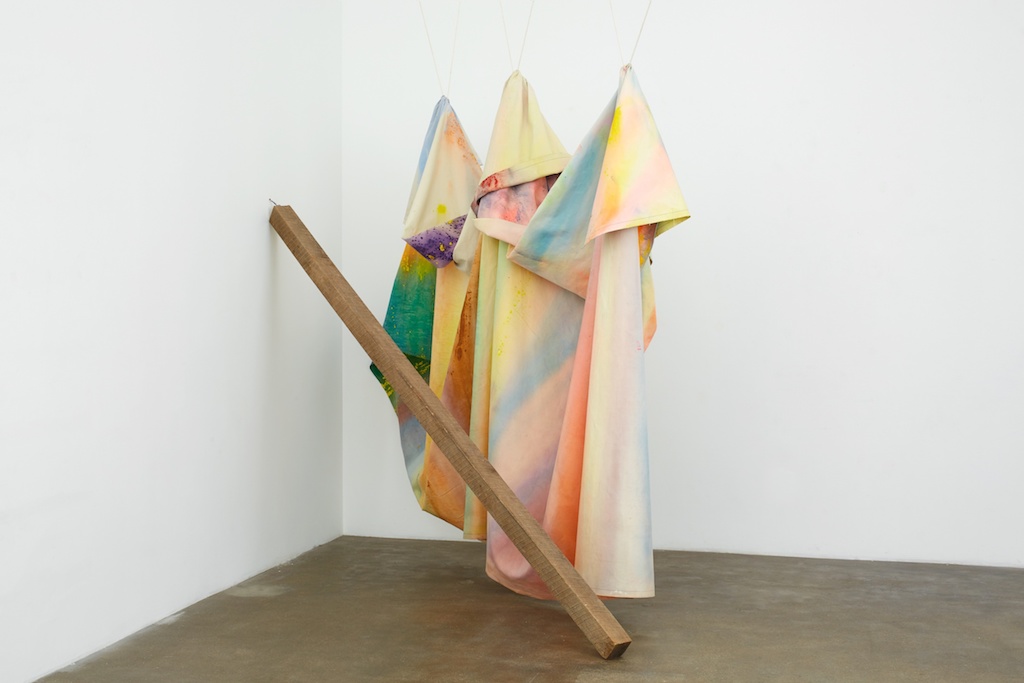
Sam Gilliam, Rondo, 1971, acrylic on canvas on oak beam.
©2018 PROLITTERIS, ZURICH/LEE THOMPSON/COURTESY THE ARTIST, KUNSTMUSEUM BASEL, AND DAVID KORDANSKY GALLERY, LOS ANGELES
MILLER: How do you feel about Venice?
GILLIAM: I worked among friends. I did it my way. That’s the title of a new Gene Ammons tune.
What did your loose canvas and stick pieces come out of?
From several things I was thinking about doing in 1968. Then my first notions were verbal, as opposed to being acted upon. I’d seen Al Held; I’d seen Stella; I’d seen shape—what we’d call erratic shape. I’d seen Barney Newmans; I’d seen Pollocks. Blue Poles was sort of a reference. I’d been painting stripes and doing this very, very hard-edged thing—getting into Albers’ interaction and working very logically with masking tape and striping. But I realized that ideas I was dealing with were mostly someone else’s. But the prelude in pre-industrial art, from which these guys’ ideas came, was also in my mind . . . what was most personal to me were the things I saw in my own environment—such as clotheslines filled with clothes with so much weight that they had to be propped up . . . That was a pertinent clue.
Did you know Noland?
I met him but arrived in Washington too late for Morris Louis, who died shortly after I came. But at the time I saw the things in Louis—the veils, unfurleds, this kind of cloggy material process—I felt closer to Hofmann, who was a long-time favorite. Louis was anti all the things I was going through. And there was a way that Olitski was going, opposed to Noland, that made me self-critical enough to say, Why not take this? A dependence upon the material, upon paint as paint, which was a reverse way of dealing with something. If you frame something in contrast you are more able to understand.
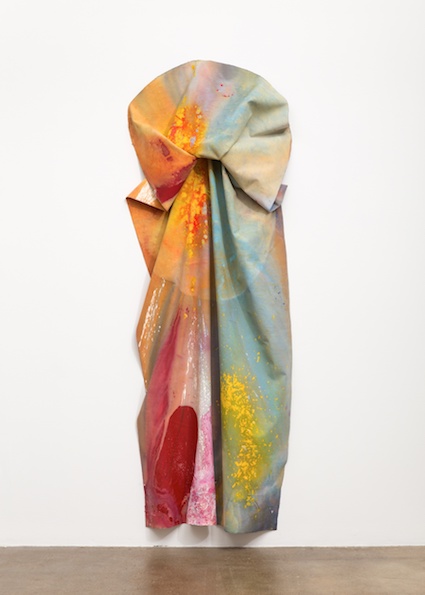
Sam Gilliam, Crystal, 1963, acrylic on canvas.
©2018 PROLITTERIS, ZURICH/FREDRIK NILSEN/COURTESY THE ARTIST AND DAVID KORDANSKY GALLERY, LOS ANGELES
You mean hunting for the area between the chevron and the unplanned softness?
Right. And trying to use that same kind of reference with an exactness that was much more a part of the 1960s than Hofmann could be. It led me to vertical folding, making a Rorschach. I heard a young artist, Peter Bradley, say, in 1971, To kill the hand was my most important move. I realized that years earlier I had thought that way in trying to free myself from the masking tape, the brush; to deal with the canvas as material by folding it, crushing it, using it as a means to a tactile way of making a painting.
How sculptural do you consider your work?
I don’t consider it sculpture. I know it’s painting. The lines are very narrow. I once heard Noland say there’s no difference between sculpture and painting once you know what you’re doing. But in formal thinking, painting is illusionistic; thus sculpture offers pictorial possibilities. I depend more upon pictorialism as a form, as an involved process delineated possibly into becoming a picture. The point you arrive at is merely transitional—there is now difference per se between painting and sculpture.
You regard folds as dimensional characteristics?
Yes, when I make the painting on the floor. If I want to stretch it on supports, it is illusionistic and is a painting. When I hang it, I am true to the process by which it is made. It is a relief—but it can be seen or moved around, depending on whether I paint bas-relief or high relief, in each case destroying illusion, lessening pictorial references.
What have you learned about form while using unstretched canvas?
You learn to open to other references. You can deal with historical substances much different. You become more interested in Dürer.
Really?
Oh, yes. Dürer is the most exciting reference in kinds of optical events, sculpturally and painterly. In front of a Dürer arch in which someone stands with a banner, the banner is blown by a breeze that immediately arcs and the banner perfectly, schematically, so that it is for me that illusion of a two-dimensional structure being pushed. I sort of have a thing for banners anyway. There were literal notions that I had when I did things called heralds. One day in the Metropolitan I realized that the relativeness of Louis’ unfurled to the unfurled means the unfurled flag and the approach to the stripes. The stripes’ sequence became, in terms of soft washes, similar to the rolling relationship in my work.
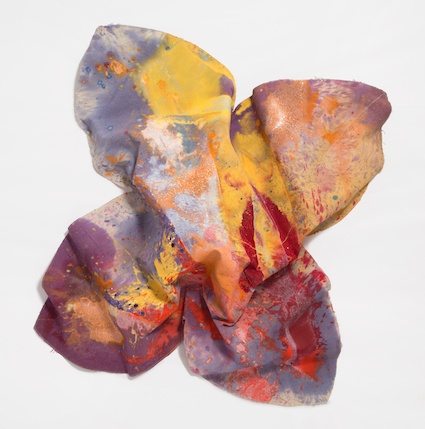
Sam Gilliam, Ruby Light, 1972, acrylic on canvas.
©2018 PROLITTERIS, ZURICH/CATHY CARVER/COURTESY THE ARTIST AND HIRSHHORN MUSEUM AND SCULPTURE GARDEN, WASHINGTON, D.C./PHOTO COURTESY DAVID KORDANSKY GALLERY, LOS ANGELES
Your technique of paint on canvas?
I pour to experience the effect of gravity. I find that when these effects have to operate within measured limits they must be precalculated at definite intervals along the horizontal length of the canvas. For example, in Carousel Merge, my piece for the Walker Art Center, the architectural problem was to put hooks freely along a wall six feet apart, diagonally under a skylight. On a 75-foot-long sheer, these were calculated to give a drop on a vertical wall of 14 feet. These became points at which everything operated. These were structural devices.
How much serendipity is there in the way folds fall?
There’s a hell of a lot.
How much do you force it or control it?
It’s planned in terms of a particular reference. With Sticks, a recent piece, there is the problem of getting it up. Using sticks placed against a ceiling that is nine-and-a-half feet high. Using 10-foot poles and a kind of rhythmic relationship that happens pleasantly within the space. I did Sticks for the Kingpitcher Gallery in Pittsburgh but just before that there was a dowel piece at the Museum of Modern Art in November, 1971. In the Projects series. It’s an environment. Downing and Mehring were strong painters dealing in environments. To return to Pollock’s Blue Poles, it works not as drips but as Marks, structurally as diagonals to the canvas edge. The angles have a sense of bending. The diagonals are part of an unfinished two-point perspective. They are also surface.
Have you worked with fluorescent paint from the beginning from the series?
With luminous qualities, such as aluminum powder. Fluorescent paint, when it was discovered, became an increment, the same as push and pull. I’m interested very much in impasto—even to the point where it escapes and cracks, when it really determines its total materiality and goes beyond the limit of what we would call control.
What fabrics do you like best next to canvas?
Silk and polypropylene. You can blow them with a fan. They are also translucent, which means you can go beyond. It’s experimental, but it becomes information that you can ride if someone says your work is “ambiguous” then you realize that quality as a component. One of the things that must be a part of art, now that artists are multimedia and art is so simultaneous it’s hard to stay on a problem, is to form one’s own problem and have tenacity.
During the time you have also worked with stretched canvases. What made you develop a beveled edge for the stretchers?
I remember that several artists were doing structured canvases very much like Lee Bontecou. William T. Williams, Neil Williams, Ron Davis all were working with ribbed stretchers and using a soft stripe. There was a kind of formless lock. If something is different as a reference we shouldn’t try to explain it completely with old rules. We should realize as we do in science that there are not only rights and wrongs but hypotheses. Therefore the substantiation of a new fact requires that we re-evaluate the hypothesis instead of rooting it out. The important thing is to create a reversal of conditions in order to allow things to exist. Of course, you can get too involved in the mental processes and not enough in making art.
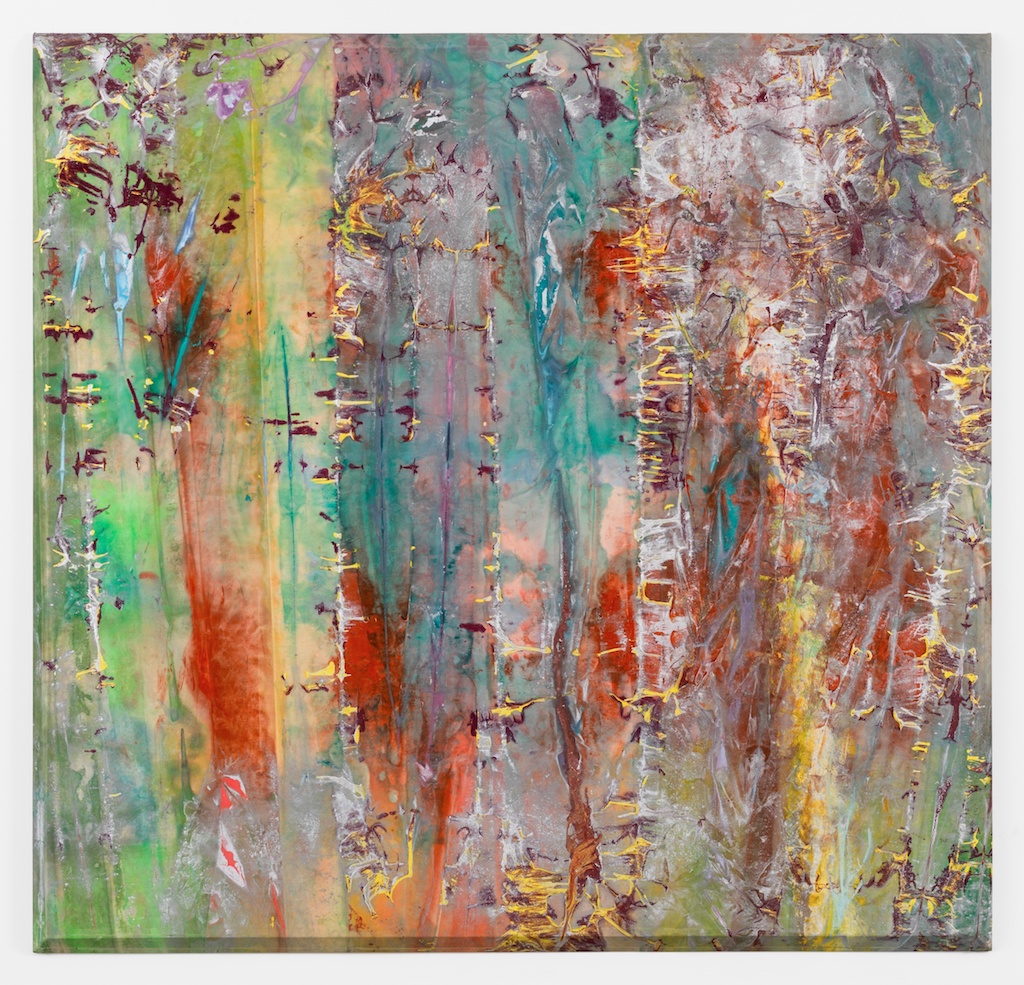
Sam Gilliam, Whirlirama, 1970, acrylic on canvas.
©2018 PROLITTERIS, ZURICH/FREDRIK NILSEN/COURTESY THE ARTIST; THE METROPOLITAN MUSEUM OF ART, NEW YORK; AND DAVID KORDANSKY GALLERY, LOS ANGELES
Do you have an affinity with Ellsworth Kelly’s floor-and-wall paintings? They haven’t received sufficient attention.
They are important. Kelly helped to spark the movement to Minimalism, to my mind. At the time, I saw work by Sven Lukin, Andre, McCracken and Anne Truitt, who were equally important to Minimal conception. I recall Howard Mehring was doing T’s and E’s back-to-back, and even Albers with Homage to the Square is a point of take-off.
Do you see yourself changing in approach?
Yes . . . In work with canvas arranged over two sawhorses—when I take advantage of the fall of paint down the canvas, creating a trailing effect that moves. Once I have established this, and folded it back on itself to dry, I have the striations and the additive process that builds up to how it was painted. Then I go into another reference so that the actual composition takes place in the gallery. The problem is to apply a method of painting in order to let that impose any conditions upon it.
Have the unstretched works all been done in sections or as one piece?
I use sections and cut them out.
You cut them after you hang them?
I’ve done both—precut and not. I got into this nutty thing. It’s like taking a Rembrandt and cutting a Donald Duck out of the center, if you want to be that obscene. But that’s what happens when you get caught up in what something can do. If there is ambiguity in anything that is done in painting or sculpture, it becomes so if one takes too firm a position in what one does—instead of recognizing that this is a trap. Because when you realize that you are ordering too persistently you freeze your spontaneity level. You have to hang loose.
What is your position on black art? You are an artist, period. But there is a separate identity.
I think there has to be a black art because there is a white art.
Do you regard your work as black art?
Being black is a very important point of tension and self-discovery. To have a sense of self-acceptance we blacks have to throw of this dichotomy that has been forced on us by the white experience. For some there is a need to do this frontally and objectively. There are some who believe there is no threat. I think there is a need to live universally.
Are you frustrated by the lack of response by blacks to visual art as opposed to other arts?
I am, to a point. But then I realize why they aren’t and then I have to be part of that spur that gets them involved. I did teach art in a Louisville high school for nine years. You know, Italy must be damn proud of Galileo. But look how they treated the dude! We must have a framework for the conflict we want.
Who is proud of the black artist in America?
I am. Even just the phrase black art is the best thing that has happened for the condition for black artists in America. It really calls attention to the number of major galleries in New York and museums around the world that had not shown, were not showing, were not willing to show any art by any black artist. Yet everyone has not come aboard, you know that. And there’s the same kind of tokenism as before. There is still not a commitment showing. But there is nothing to suggest in the history of men that we would ever arrive at a utopia. The individual black will be able to be successful but en masse, no.
[ad_2]
Source link

